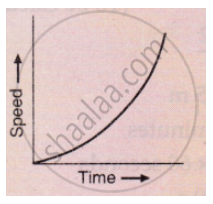Advertisements
Advertisements
प्रश्न
What conclusion can you draw about the acceleration of a body from the speed-time graph shown below .

उत्तर
It represents non-uniform acceleration. In this kind of motion, speed doesn’t vary linearly with time.
APPEARS IN
संबंधित प्रश्न
Given alongside is the velocity-time graph for a moving body :
Find :
(i) Velocity of the body at point C.
(ii) Acceleration acting on the body between A and B.
(iii) Acceleration acting on the body between B and C.

Study the speed-time graph of a car given alongside and answer the following questions:

(i) What type of motion is represented by OA ?
(ii) What type of motion is represented by AB ?
(iii) What type of motion is represented by BC ?
(iv) What is the acceleration of car from O to A ?
(v)What is the acceleration of car from A to B ?
(vi) What is the retardation of car from B to C ?
Draw a displacement-time graph for a boy going to school with uniform velocity.
What does the slope of velocity-time graph represent?
From the displacement-time graph of a cyclist given below in the Figure, find The time after which he reaches the starting point .

Diagram shows a velocity – time graph for a car starting from rest. The graph has three sections AB, BC, and CD.

In which section, car has a zero acceleration?
From the diagram given below, calculate distance covered by body.

What can you conclude if the speed-time graph of a body is a straight line sloping upwards and not passing through the origin?
Draw the following graph:
Speed versus time for a stepped motion
The area under the v-t graph represents a physical quantity that has the unit.
